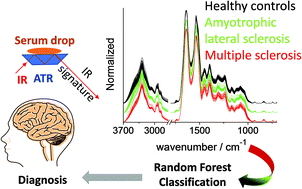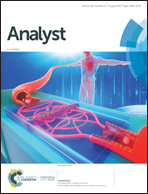Serum-based differentiation between multiple sclerosis and amyotrophic lateral sclerosis by Random Forest classification of FTIR spectra†
Abstract
The challenging diagnosis and differentiation between multiple sclerosis and amyotrophic lateral sclerosis relies on the clinical assessment of the symptoms along with magnetic resonance imaging and sampling cerebrospinal fluid for the search of biomarkers for either disease. Despite the progress made in imaging techniques and biomarker identification, misdiagnosis still occurs. Here we used 2.5 μL of serum samples to obtain the infrared spectroscopic signatures of sera of multiple sclerosis and amyotrophic lateral sclerosis patients and compared them to those of healthy controls. The spectra are then classified with the help of a two-fold Random Forest cross-validation algorithm. This approach shows that infrared spectroscopy is powerful in discriminating between the two diseases and healthy controls by offering high specificity for multiple sclerosis (100%) and amyotrophic lateral sclerosis (98%). In addition, data after six and twelve months of treatment of the multiple sclerosis patients with biotin are discussed.



 Please wait while we load your content...
Please wait while we load your content...